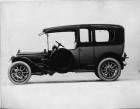|
The Electromatic Clutch
|
||||
|---|---|---|---|---|
|
Home away from home

|
Anyone had experience with the Electromatic Clutch or rebuilding one ?
Posted on: 2020/5/11 0:57
|
|||
|
||||
|
Re: The Electromatic Clutch
|
||||
|---|---|---|---|---|
|
Home away from home

|
As demonstrated by today's automatic dry clutch transmissions, on a theoretical basis the unit should lead to longer clutch life due to the calibrated throttle engagement equivalence relationship. However, somewhere in the documentation I recall seeing early clutch wear problems.
When the units were new they appeared to work as witnessed by Tom McCahill not ripping the unit. The linkage mechanisms seem subject to excessive slop, although the ones I dealt with did work well enough for demonstration purposes.
Posted on: 2020/5/11 9:27
|
|||
|
||||
|
Re: The Electromatic Clutch
|
||||
|---|---|---|---|---|
|
Forum Ambassador
|
In addition to what Ross has suggested also check out the solenoid valve on the bottom of the control unit and any hoses used to connect the piping to the power unit for leaking. I found on my unit the rubber had dried and warped on the solenoid piston so the valve would not seal.
Unlike the prewar units, the postwar unit only has the one solenoid which is a valve used to completely cut off the vacuum. The speed and harshness of the clutch engagement is controlled by mechanical linkage moving a spool valve in the control unit in proportion to the accelerator opening. A spring controlled diaphragm works with residual vacuum to operate a collar which surrounds the spool valve and that moves in proportion to the power unit. The amount of vacuum available to operate the power unit and speed it moves is controlled by adjustment screws limiting linkage range or controlling the speed vacuum bleeds off which determines the relative positioning of the spool valve and collar component to each other. Using the speed and amount the diaphragm moves the collar surrounding the spool valve, the control valve is able to sense via the amount of vacuum in the system the relative strength and position of the power unit so as to guess when the clutch is nearing engagement. If the solenoid valve is leaking and allowing more vacuum to keep entering the control valve assy or too much is leaking out a damaged hose, that sensing ability is messed up and clutch engagement becomes very erratic. As Ross also suggested the operation may not be perfect. There is one set of adjustments for one driver under a best case condition. Anything outside that condition will be a compromise and may not exactly suit the situation. You also will not be doing much speed shifting. Like the gearshift linkage liking to be handled in a sedate, precise and orderly manner so it does not lock up, the clutch operation can also be slow and refined. Other than replace the solenoid valve I have not played with the unit in my current Clipper since the car is not on the road but on my first Clipper where it was also installed I found the adjustments and test drives between to be very tedious. The adjusting screws need a very tiny amount of turning to make a difference. The training manual for the postwar EC is in the literature section training manual category and is in the manual entitled Clutch and Electromatic Clutch.
Posted on: 2020/5/11 9:55
|
|||
|
Howard
|
||||
|
||||
|
Re: The Electromatic Clutch
|
||||
|---|---|---|---|---|
|
Home away from home

|
Thank you - Ross, Tim Cole, and HH 56
Posted on: 2020/5/11 20:29
|
|||
|
||||








